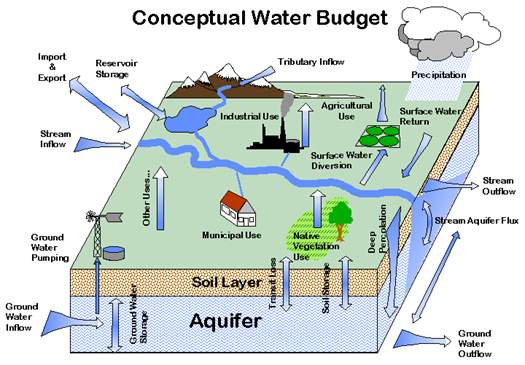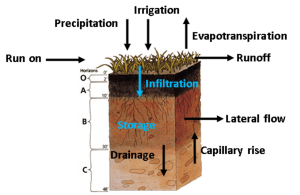Chapter 101.1 – A Systems Approach to Irrigation Water Management
A Systems Approach
In this 4 min video clip, Dr. Andales will introduce you to the concept of looking at water use and management from a larger, systems approach. He illustrates how different components are connected together and influence best practices in water management. After watching this video, continue on with the text below to learn more details.
The systems approach is a problem-solving pattern that considers a physical or conceptual group of entities that interact and function as a whole unit. The physical or conceptual boundaries are clearly defined to separate the unit from its broader environment. This helps simplify analyses of the system in terms of specific attributes or characteristics.
- In the case of irrigation systems, the whole unit (system) could be composed of the different parts (entities) that deliver and apply water to the plants. For example, a sprinkler irrigation system can be composed of a pump, main pipeline, valves that control water flow to individual laterals or zones, and the sprinkler nozzles that apply the water to each zone. The water flow rates in the different parts of the system would be an attribute of interest to the irrigator. At a much larger scale, a region or entire landscape can also be considered a system with clearly defined boundaries (Fig. 1-1).

- From the perspective of a water manager, the fluxes (i.e. flows) of water within the system and across its 3-dimensional boundaries would be of interest so that the total amount of water available for growing plants can be estimated.
In this lesson we will use the concept of “unit area” to define our system, which we will use to estimate the amount of water that is available to the plants and to estimate the irrigation water requirement.
Unit Area
A unit area is a pre-determined surface area including plants and the soil or growth medium that they occupy. The unit area can be arbitrary, but is typically chosen based on the preferred measurement units such as square foot, square meter, 1 acre, 1 hectare, etc.
Since the goal of irrigation is to foster plant growth, then we are also interested in the root zone that is connected to the unit area because the root zone is the water reservoir from which the plants extract water.
In the following 2 minutes video clip, Dr. Andales describes more the idea of “unit area”, including an introduction to a diagram and SPA system. Click the play arrow to begin. To view the video in full screen, click on the full screen square button in the lower right-hand corner of the video.

A diagram of a unit area with its associated root zone and water fluxes is shown in Fig. 1-2. We will focus on this system to determine the amount of water that is available to the plants at any given time and also to determine how much and when to apply the irrigation water.
A portion of the water held in the root zone (storage) is available for uptake by the plant roots.
- Precipitation, irrigation, and run on (i.e., water flowing on the surface from adjacent areas) are the main sources of water at the surface.
- Depending on the rate of precipitation or irrigation, some of the water is lost from the system as runoff while some enters the root zone via infiltration.
- Water in the root zone may leave the system as drainage or lateral flow. If there is a shallow water table below the root zone, then capillary rise of water into the root zone could also add to storage
- Evapotranspiration (ET) is water lost from the system through transpiration from plant leaves and evaporation from the soil surface.
The irrigation water requirement is determined by tracking the storage of water in the root zone, while considering the sensitivity of the plants to water stress (i.e., drought).
Review
Answer the following questions based on what you have learned in this chapter.

Earn an industry recognized micro-credential at: CSU Upskill.
Systems approach - a problem-solving pattern that considers a physical or conceptual group of entities (parts) that interact and function as a whole unit.
Sprinkler irrigation system - the combination of parts (pump, main pipe line, valves, nozzles, laterals, zones) that are used to apply irrigation water by sprinkling on plants.
Unit area - a pre-determined surface area including plants and the soil or growth medium that they occupy. The unit area can be arbitrary, but is typically chosen based on the preferred measurement units such as square foot, square meter, 1 acre, 1 hectare, etc.
Root Zone - same as rooting depth.
Water reservoir - a structure, such as a man-made lake, that stores water for future use.
SPA - soil-plant-atmosphere system.
Precipitation - water from the atmosphere that falls to the ground.
Irrigation - the artificial application of water on plants to promote growth.
Run on - water flowing on the surface from adjacent areas.
Runoff - water flowing on the ground surface away from the field.
Infiltration - movement of water into the soil surface.
Drainage - water that flows downward from the bottom of the soil root zone.
Lateral flow - horizontal movement of water in the soil.
Capillary rise of water - groundwater that rises into the soil root zone through small soil pores called capillaries.
Evapotranspiration (ET) - water lost from the soil-plant system through transpiration from plant leaves and evaporation from the soil surface.
Transpiration - evaporation of water through the leaves of plants.
